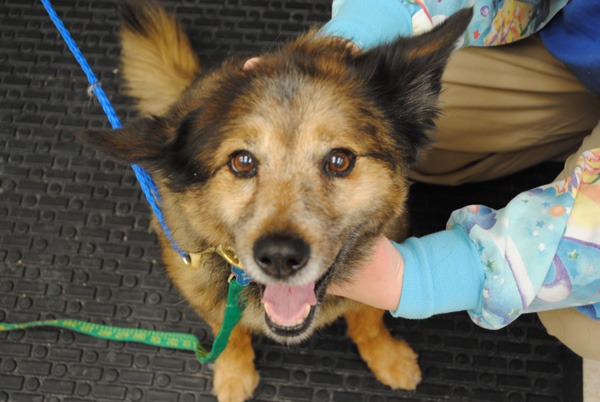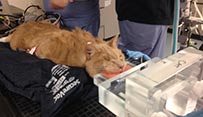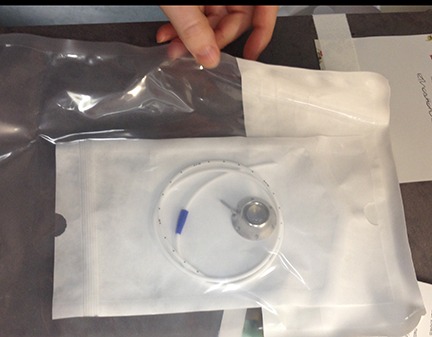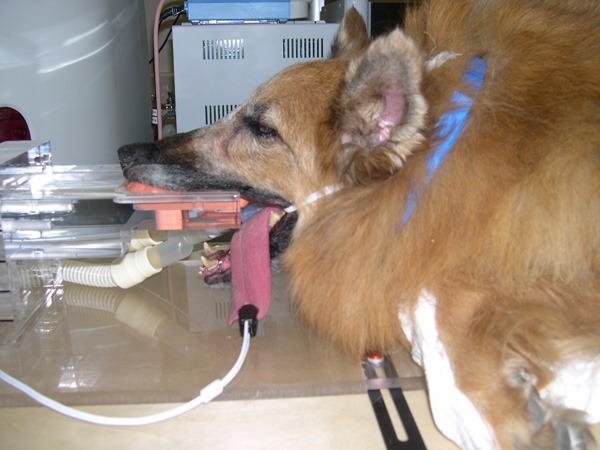-
Adopt
-
Veterinary Care
Services
Client Information
- What to Expect – Angell Boston
- Client Rights and Responsibilities
- Payments / Financial Assistance
- Pharmacy
- Client Policies
- Our Doctors
- Grief Support / Counseling
- Directions and Parking
- Helpful “How-to” Pet Care
Online Payments
Referrals
- Referral Forms/Contact
- Direct Connect
- Referring Veterinarian Portal
- Clinical Articles
- Partners in Care Newsletter
CE, Internships & Alumni Info
CE Seminar Schedule
Emergency: Boston
Emergency: Waltham
Poison Control Hotline
-
Programs & Resources
- Careers
-
Donate Now
Welcome to Angell’s Oncology services.
After your pet’s diagnosis, Angell’s doctors will develop a custom, comprehensive treatment plan, ensuring the best care possible.
In this video, watch as two of our patients receive an advanced form of radiotherapy. An Angell team of multiple specialists including veterinary pathologists, anesthesiologists, soft tissue surgeons, and radiation oncologists work together to deliver the most comfortable, effective treatment available.
What Types of Radiation are Available?
The type of radiation recommended is based on discussion with clients and the goals we aim to achieve. In general there are 2 main intents of radiation therapy: palliative and definitive. Of course there is an exception which is coarse fractionated radiation therapy which is a palliative schedule with a definitive intent.
Definitive radiation therapy traditionally consists of delivery of small daily doses given Monday through Friday over 3-4 weeks (veterinary). Definitive intent radiation is employed when there is a potential for long-term control of a tumor. Stereotactic radiation is another definitive methodology that is highly specialized and typically delivered over 1-5 closely scheduled treatments.
Coarse fractionated radiation therapy, is a protocol that is between definitive and palliative by means of definition. Course fractionated radiation therapy uses larger doses per fraction, as in palliative therapy, however the goal is curative. There are certain tumors that respond better to this type of protocol. Malignant melanoma is an example of such a tumor.
Palliative radiation therapy consists of less, larger fractions of radiation therapy with the intent to alleviate pain and clinical signs associated with the tumor. This is different from stereotactic radiation which also uses large doses per fraction, however it is typically used for curative intent. Palliative radiation therapy is used to improve the patient’s quality of life and typically does not have long term control. This protocol is less intensive and less expensive.
Newer Technologies in Veterinary Radiation Oncology
IMRT
Intensity-Modulated Radiation Therapy is an advanced form radiation planning. IMRT can be used when delivering definitive (conventional or stereotactic radiation therapy) or palliative intent radiation therapy. Angell is currently one of only two veterinary hospitals in New England to offer the treatment, and the only one to offer it in conjunction with routine VAP placement. IMRT allows for the computer-controlled radiation dose to conform precisely to the shape of the tumor by modulating (adjusting) the intensity of the radiation beams. The radiation dose intensity is elevated at the tumor, while radiation among neighboring normal tissue is decreased or avoided completely. The customized radiation dose is intended to maximize the dose intended for the tumor while simultaneously protecting the surrounding normal tissue, reducing side effects. IMRT also improves the ability to conform the treatment to tumor shapes, for example when a tumor is wrapped around a vulnerable structure such as the spinal cord, a major organ, or blood vessel. The net effect is that radiation doses can be “wrapped” around tumors, or “painted” within tumors, far more precisely than was previously possible. Radiation therapy, including IMRT, stops cancer cells from dividing and growing, thus slowing or stopping tumor growth. Radiation therapy in general is often used in conjunction with surgery and/or chemotherapy.
Conventional RT vs. IMRT – Side effects after 2 weeks
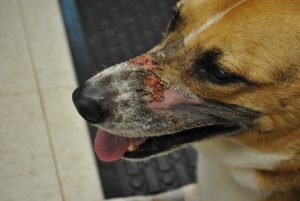
“Lilly,” a conventional radiation therapy patient, continuing to heal 2 weeks after treatment for a nasal tumor.
IMRT for Felines
IMRT is also an effective treatment option for felines, such as Dolce (see photo). This is Dolce’s second battle with cancer; he lost his right eye to a tumor two years ago. Dolce is being treated for a nasal lymphoma, a cancerous tumor inside his nasal passageway. Similar to Bodie’s case, IMRT allows Angell’s oncology team to effectively treat Dolce’s cancer without causing further damage to the tissues of his face and nearby organs.
Stereotactic Radiation Therapy:
We are excited and proud to be the first veterinary hospital in New England offering this cutting edge technology with a Varian TrueBeamTM system. Stereotactic radiation therapy (SRT) is a highly specialized form of radiation delivery that delivers 1-5 highly conformal doses of radiation to a tumor with submillimeter accuracy. This technology has several proposed advantages over traditional fractionated radiation therapy including reduced side effects and fewer anesthetic events.
Multiple terms have been used for stereotactic-based radiation that includes stereotactic radiosurgery (SRS) and stereotactic body radiation therapy (SBRT). In a purest sense, SRS is used when describing a single high dose of radiation delivered to a lesion in the brain and contrary to its name, it does not involve physical surgery. Stereotactic body radiation is used to describe when delivering high dose radiation over 1-5 treatments outside the brain.
Image-Guided Radiation Therapy:
Image guided radiation therapy (IGRT) uses images of the patient at the time of treatment to determine the accuracy of setup so that corrections can be made in real time before the treatment is delivered. Our system can use cone beam-Cat scans (CBCT) and kilo-voltage x-rays (the energy used to take diagnostic x-rays) to confirm patient positioning to within millimeters of error. By verifying the actual location of the tumor target and relying less on an external landmarks, we are more likely to deliver the necessary dose to sterilize the disease and avoid inadvertently delivering dose to adjacent critical structures, thus significant decreasing side effects.
IMRT for Felines
IMRT is also an effective treatment option for felines, such as Dolce (see photo). This was Dolce’s second battle with cancer; he lost his right eye to a tumor two years prior. Dolce was treated for a nasal lymphoma, a cancerous tumor inside his nasal passageway. Similar to Bodie’s case, IMRT allows Angell’s Oncology team to effectively treat Dolce’s cancer without causing further damage to the tissues of his face and nearby organs.
What is a VAP, or Vascular Access Port?
Angell is the only veterinary hospital in the Boston area that routinely uses this technique for radiation patients. The vascular access port, an implanted catheter device, can be used to administer anesthesia for radiation therapy, for chemotherapy drugs, or even for administering fluids. Using these ports allows for shorter treatment sessions and far greater comfort for the patient. It eliminates the need (or time/discomfort involved) for daily catheter placement and consequently eliminates the need for sedation. Clients are frequently happy to take their pets home following radiation treatments without the after-effects of sedation. We use the vascular access ports for all of our patients receiving full course radiation, including IMRT. Used for both cats and dogs, it is a great benefit for cats with small veins for whom placing an IV catheter can be difficult.
What is a bite block? How is it used?
A bite block is a custom-made dental mold used to immobilize and position the patient during radiation therapy. In order to reap the benefits of IMRT, our team must be able to perform well-executed delivery of a prescribed radiation dose. The two key factors here are patient immobilization and real-time imaging to verify the patient is in the correct position. Immobilization that is reproducible is essential; there is no sense in an elaborate setup that cannot be reproduced, or leaves room for error. Various devices are used to position the patient into an easily reproducible position, such as dental molds and bite blocks (for tumors where the head must be immobilized, such as Bodie’s). To aid in the immobilization, general anesthesia is needed. Bite blocks are specific for certain tumors in the head/neck area – there are other immobilization and positioning devices and methods for tumors located in other areas of the body.
Each veterinary oncology patient must be evaluated locally and systemically to best practice individualized medicine. Radiation therapy can be used as a standalone therapy or in conjunction with other therapies such as surgery and chemotherapy. Consultation with a veterinary oncologist is the first step in designing such a tailored protocol for your pet. If you have any questions about Angell’s Oncology Service, please call 617-541-5136 or email oncology@angell.org.
